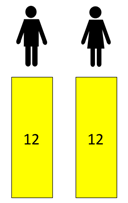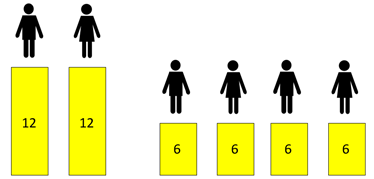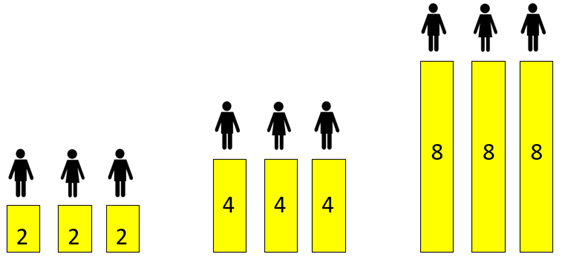The purpose of this activity is to support students in applying division to solve equal sharing problems, without needing to use multiplication ‘build up.’ Students are encouraged to extend their use of multiplication and division basic facts by using patterns to solve equal sharing problems.
- Individual objects of interest and relevance to students. This lesson uses connecting cubes
- A calculator.

Pose an equal sharing problem that requires students to think beyond multiples of two, five or ten.
I have 24 cubes to share between two people. How many cubes will each person get?
Look for students to halve 24 to get an answer of 12 cubes per person.
Record the answer using a schematic diagram.- Write a set of equations for the diagram.
- Multiplication: 2 x 12 = 24, 12 x 2 = 24, 1/2 x 24 = 12
- Division: 24 ÷ 2 = 12, 24 ÷ 12 = 2
Introduce the te reo Māori kupu for divide/division (whakawehe) and multiply/multiplication (whakarea) if appropriate to your students' knowledge. - Use a calculator to model and confirm the expressions.
- Extend the problem:
I have 24 cubes to share between four people. How many cubes will each person get? Can you use your answer to 24 cubes shared between 2 people to solve this problem?
- Let students attempt the problem. Look for students to recognise that doubling the number of shares halves the amount of each share. Show the result and this relationship using schematic diagrams.

- Record the equations below the previous ones:
- Multiplication: 4 x 6 = 24, 6 x 4 = 24, 1/4 x 24 = 6
- Division: 24 ÷ 4 = 6, 24 ÷ 6 = 4.
What patterns do you notice? - Use a calculator to model and confirm the expressions.
- Extend the pattern to sharing 24 cubes equally among eight people. Use schematic diagrams and written equations to record the problem. Use a calculator to model and confirm the expressions.
- Pose connected problems with the purpose of students gaining competence at using division equations. Allow students to work in groupings that will encourage peer scaffolding and extension. Some students might benefit from working independently, whilst others might need further support from the teacher. Consider also the different means of action and expression (e.g. verbal, written, digital, physical) that your students might use to demonstrate their thinking. Provide time for students to share their strategies and calculations with range of peers.
Encourage students to use known facts to get new results, to use schematic diagrams and written equations to record the problem, and to use a calculator to model and confirm the expressions.
Examples might be:- I have 30 cubes to share between 3 people. How many cubes will each person get?
I have 30 cubes to share between 6 people. How many cubes will each person get - I have 16 cubes to share between 2 people. How many cubes will each person get?
I have 16 cubes to share between 4 people. How many cubes will each person get?
I have 16 cubes to share between 8 people. How many cubes will each person get? - I have 30 cubes to share between 3 people. How many cubes will each person get?
I have 27 cubes to share between 3 people. How many cubes will each person get?
I have 27 cubes to share between 9 people. How many cubes will each person get?
- I have 30 cubes to share between 3 people. How many cubes will each person get?
- Pose problems where the divisor, meaning the number of equal shares, remains constant but the amount to be shared varies.
Encourage students to use known facts to get new results, to use schematic diagrams and written equations to record the problem, and to use a calculator to model and confirm the expressions.
Examples might be:
- I have 15 cubes to share between 3 people. How many cubes will each person get?
I have 18 cubes to share between 3 people. How many cubes will each person get?
I have 21 cubes to share between 3 people. How many cubes will each person get? - Other variations might include doubling, such as:
I have 6 cubes to share between 3 people. How many cubes will each person get?
I have 12 cubes to share between 3 people. How many cubes will each person get?
I have 24 cubes to share between 3 people. How many cubes will each person get?
- Challenge students to use the known result of an equal sharing situation to estimate the result of a related problem.
- If you share 28 cubes among four people, then they get seven cubes each?
What are the equal shares for 28 cubes among four people?
Are the shares for four people bigger or smaller, than for seven people? Why?
Estimate the shares for 36 divided by four. - If you share 36 cubes among six people, then they get six cubes each.
What are the equal shares for 36 cubes among four people?
Are the shares for four people bigger or smaller, than for six people? Why?
Estimate the shares for 36 divided by four.
Next steps
- Increase the level of abstraction by using diagrams without visible numbers of cubes. Progress to using stories and equations only.
- Ask anticipatory questions based on a trusted result, such as:
If I know 18 ÷ 3 = 6, what other equal sharing problems can I solve?
- Extend the problems that can be solved to include a full range of basic facts. Connect division facts to facilitate student memory and flexibility, such as:
I have 36 cubes to share between 2 people. How many cubes will each person get?
I have 36 cubes to share between 4 people. How many cubes will each person get?
I have 36 cubes to share between 6 people. How many cubes will each person get?
I have 36 cubes to share between 3 people. How many cubes will each person get?